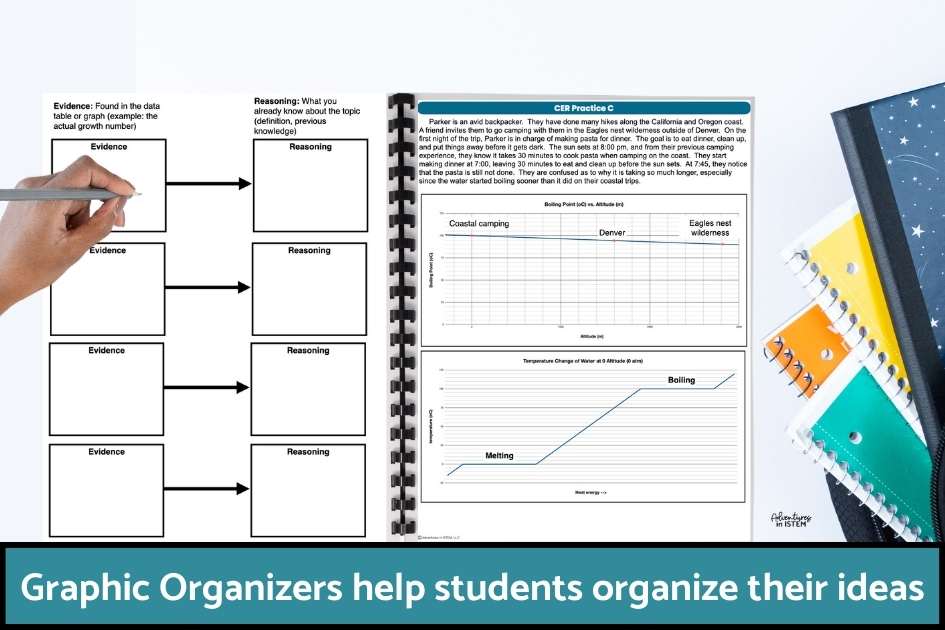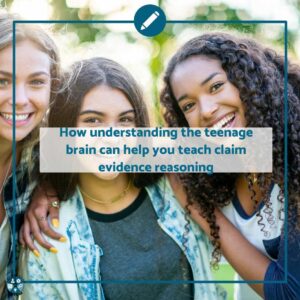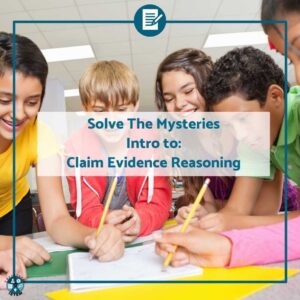Are your students struggling with writing scientific explanations using the claim evidence reasoning format? These seven simple steps will help break down a CER and guide students through answering questions using the claim evidence reasoning format.
Claim evidence reasoning is a way for students to give a scientific explanation to a question. In the claim, the students will state their answer. They then use evidence from the data, graphs, and diagrams to support their claim. The reasoning brings it all together using scientific knowledge to explain why and how the evidence supports the claim. Many students struggle with writing a claim evidence reasoning; however, these simple steps will take them from feeling frustrated to confident as they master a claim evidence reasoning paragraph.
Step 1: Identify the question in the Claim Evidence Reasoning Assignment
Now, this might seem like an obvious first step that doesn’t even need to be addressed. But, I have found that some students have trouble looking at an experiment and figuring out what they are being asked to do. This is why, whether you think they need it or not, it is essential to model and guide students through identifying the question they will be answering.
Step 2: Look at the data table, graph, and diagram and record observations.
I like to have my students fill out a graphic organizer that allows them to fill out their observations or evidence on one side and what they know about the topic or why they recorded the evidence, in other words, the reasoning on the other side. I take them through how to read a data table or graph. I lead them through looking at diagrams to pull out the critical information it is showing. Using a graphic organizer to record the observations will help the students later when they start to write their CER.

Step 3: Look over the evidence and reasoning and write the claim.
Now that they have looked through the information about an experiment or study, they can use their observations to write their claim. First, have them re-read the question. Next, have them look at the observations they recorded in their graphic organizer. Before they write their claim, have them discuss what it would be with a partner or group. When they write their claim, they need to use the keywords from the question. When I practice CER in chemistry, an example question would be, When you mix copper chloride and aluminum, does a chemical reaction occur? Their claim should include the names of the two chemicals and the words chemical reaction. Their claim could, when you mix copper chloride and aluminum, a chemical reaction occurs.

Some of my students like to add the word because to their claim when they are starting to give the reason for why they made it. I explain to my students that in most cases, the word because is left out of the claim. The claim should end before the word because since it is a statement. Anything after the word because is the evidence and reasoning and belongs in those sections as new sentences.
Step 4: Use the evidence to support the claim.
Now that they have stated the answer to the question in the form of a claim, they need to provide evidence that supports their claim. I try to explain to my students that a question can have more than one claim based on the evidence used to support it. To make it easier, students can use what they recorded in their graphic organizer to help write their evidence sentences. Students need to ensure that their evidence sentences include numbers from the data tables and graphs when given. It’s not enough to say that the temperature increased. They need to explain how they knew it increased by stating the beginning and ending temperature.

Step 5: Write the reasoning to explain how the evidence supports the claim.
Many students get confused with evidence and reasoning. Reasoning explains why and how the evidence supports the claim. The reasoning uses the scientific principles we already know. It explains why the evidence is important and what it is showing. One thing that I have found that has helped students to differentiate between evidence and reasoning is by using a quick little check. If the information comes directly from the data table, graph, or diagram; in other words, the actual numbers, colors, and species interaction, then it is evidence. If the information is an explanation, definition, or scientific principle, then it is reasoning.
This is why having the students first break the experiment or study down using a graphic organizer where they write the evidence on one side and reasoning on the other can be super helpful. You can check and edit their graphic organizers and have them share them with a partner or group before they even start to write their CER. Then they can use what they wrote on the reasoning side to explain the evidence and connect it to the claim.
Step 6: Put your claim evidence reasoning sections together into a paragraph.
When my students write their claim evidence reasoning, I usually have them write each part as a separate piece first. This way, they focus on only one part at a time. This also allows students to discuss each part with a partner or group and for us to go over the information together as a class. Then I have them join all of the pieces together into one paragraph. After they create their paragraph, it is crucial to have them read out loud the paragraph. This is best done by having students read their paragraphs to their partners. Reading the paragraph aloud helps students identify mistakes and see if it flows smoothly.
Step 7: Check that you have the key parts.
The last thing I have my students do is to complete a self-check list. This helps them to identify that they have all the key parts. Including the claim evidence reasoning, that the evidence includes numbers if given in the data table or graph, that the reasoning explains why and how the evidence supports the claim, and that there are no spelling or grammar errors.
Repeating these seven steps every time they write a scientific explanation will help students gain the confidence they need to master the claim evidence reasoning paragraph. As students go through the process over and over again, you will notice that the time it takes them to go through an experiment or study and write their scientific explanation will decrease as they start to become more confident. Writing a CER does take time; sometimes, a CER can take a whole class period.

If you would like more specifics on teaching claim evidence reasoning in subject areas, check out my other blog posts about CER.





